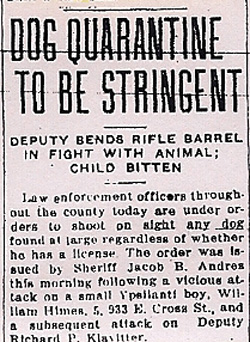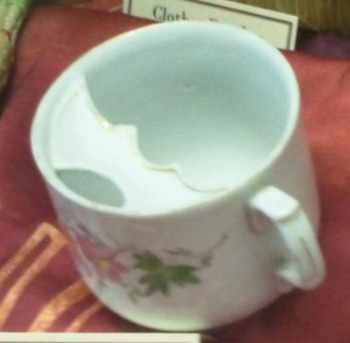In the Archives: Muzzling Rabies
Editor’s Note: The Washtenaw County’s public health department web page, updated on Aug. 12, 2011, shows three cases of rabies found in Washtenaw County bats so far this year. Since 2004, most years show 2-3 cases of rabies in bats. In 2009 there were none; but in 2007, 11 cases of bat rabies were recorded. Since 2004, no cases of rabies in dogs have been recorded in Washtenaw County. This week local history writer Laura Bien takes a look back to the early 1900s, when rabies was more prevalent.
The severed head of a small white poodle was sent from Ypsilanti to Ann Arbor in the summer of 1935.
It wasn’t a grisly threat or an act of revenge. The head’s recipients were neither surprised nor disgusted. Severed dog heads were their stock in trade.
The poodle had belonged to Herbert Wilson of Ypsilanti’s northside Ann Street. The dog was “so vicious,” according to the Aug. 6, 1935 Ypsilanti Daily Press, “that even after being wounded by the officers’ rifle fire, [Officer] Klavitter had to strike him with the gun to protect himself. The blow bent the rifle barrel and the officer had to use a nearby tree limb to finish killing the dog.”
The dog had bitten 5-year-old William Himes on his right arm and leg, in an era when a dog bite could lead to an agonizing death.
Dogs in Ypsilanti that August were under quarantine, meaning that they had to be contained within the owner’s home or property. Dogs that broke loose or wandered into the street could be shot on sight by police. In earlier years, anyone was welcome to take their rifle or shotgun into the street and play Atticus Finch with mad dogs.
In the summer of 1909 Ypsilanti’s Board of Health proclaimed, “For a period of three months from the date of this notice, all dogs, male or female, muzzled or unmuzzled, running at large on any street, alley, or public grounds, or on private premises, not the premises of the owner or keeper thereof, may be killed by any person …”
The precautions were not enough. Just a few days later, 14-year-old Morton Crane was bitten. “Many dogs have been killed since the Crane boy was bitten,” reported the June 16, 1909 Ypsilanti Daily Press, “and the warm weather of the past few days is making the mothers and fathers anxious while their children are playing on the street. Chief Gage is using every effort to prevent another scare and every dog seen on the streets without a muzzle is being shot regardless of the value of the animal …” Ann Arbor also had its share of incidents.
The fear was rabies.
There was no cure, and little warning, as the disease initially presents in an insidiously innocuous form. Those infected can be symptom-free for months – even up to a year or two. The first signs are flu-like symptoms. Left untreated, these progress to anxiety, confusion, insomnia, brain dysfunction, paranoia, and painful paralysis of the throat and jaw.
The term “hydrophobia” comes from the natural swallowing reflex, made intensely painful by rabies – even the sight of water is enough to trigger an agonizing throat spasm, hence aversion to liquids despite increasing thirst. The rabies virus’s ongoing damage to the central nervous system can lead to seizures, paralysis, coma, and heart or respiratory failure.
Though rabies doesn’t give much warning with its mild initial symptoms, it usually leaves a calling card in its wake: Negri bodies. A post mortum analysis can reveal the abnormal structures in brain nerve cells. They were first discovered by Italian pathologist Adelchi Negri in 1903.
In April of that year, the University of Michigan opened its Pasteur Institute on campus, specifically for the diagnosis and treatment of rabies. Pasteur had famously discovered the vaccine for rabies in 1885. UM’s Pasteur Institute was, and for many decades remained, the only such rabies treatment clinic in the state. It was the sixth such institute to open in the United States. Dog-bite victims from around Michigan came to Ann Arbor for the “Pasteur cure,” consisting of 21 or more injections of rabies vaccine in the abdomen, initially over a period of eighteen days.
The institute charged $25 ($600 today) for the treatment. Room and board was extra. An act of the Michigan legislature mandated that paupers could receive treatment for free, paid for by local municipalities. The institute also examined dog brains under the microscope, looking for Negri bodies so as to confirm a diagnosis of rabies.
By 1920, the institute had treated nearly 1,600 human cases of the disease. But without a rabies vaccine for dogs, the malady persisted.
Dogs were quarantined in Ypsilanti throughout the Depression. In the 1940s, a rabies vaccine for dogs was finally developed. By 1941, the institute claimed to have treated 2,815 cases of rabies, all successfully.
Well, almost all successfully. In 1911 a three-year-old boy arrived at the Institute for treatment, having been bitten three weeks previously. “The dog was shot and the brain sent to the University of Michigan Pasteur Institute and pronounced rabid,” reported a case study in the August 1911 issue of Physician and Surgeon magazine. “A report was immediately sent to the parties concerned, requesting that the child be brought here for treatment. As the child did not appear, after some length of time, Doctor Gumming sent a second urgent telegram. Still the child was not brought here until a week or ten days later.”
It was too late. The child couldn’t take food or water. He was finally admitted on the afternoon of May 29, 1911, and died a day later.
In the fall of 1917, another advanced case, a young schoolboy, was admitted to the Institute at noon. He died shortly after midnight.
The sadly failed cases were exceptions. UM’s Pasteur Institute was a leader in eradicating rabies in the state. In tandem with other anti-rabies efforts, the institute was so successful that it made itself obsolete. In the 1940s, vaccines for dogs were developed; 1948 marks the last incidence of human rabies in Michigan until the 1980s.
By then, thanks to dog vaccination campaigns in the 1950s and 1960s, dog-borne rabies had almost entirely disappeared. After 1960, the primary host of rabies in Michigan became wildlife, particularly bats. That remains true now, though only a tiny percent of bats are actually infected.
Today parents need not worry about the dog days of August, thanks to UM’s pioneering Pasteur Institute and its good work in detecting and treating the onetime scourge of summer.
Mystery Object
No one correctly guessed the identity of the sinister-looking mystery artifact from the last column.
Housed in a case on the second floor of the Ypsilanti Historical Museum, the “jackknife thingy,” as one commenter called it, is a doctor’s bloodletting knife, evocative of an age of considerably cruder medical knowledge.
This time we have an artifact more connected to bodily appearance than bodily health. Here’s a strange-looking vessel. What might it be? Take your best guess and good luck!
Laura Bien is a local history columnist and collector of non-functioning Depression-era gas station cash registers. Her second book, “Hidden Ypsilanti,” is due out this fall. Contact her at ypsidixit@gmail.com.
The Chronicle relies in part on regular voluntary subscriptions to support our publication of columnists like Laura Bien. Click this link for details: Subscribe to The Chronicle. And if you’re already supporting us, please encourage your friends, neighbors and colleagues to help support The Chronicle, too!






Shaving mug?
Interesting guess Mr. P. Should this appeal to you here are some 1916 instructions on how to make your own electric shaving mug. Perfectly safe!
Mustache mug, to keep the drinker’s mustache dry.
Laura, the mystery item is a mustache cup. Kept the mans mustache from getting hot liquids onto it, which would melt his mustache wax.
cmadler & Dave: I thought that this one would be mysterious to some folks and easy-peasy for others… :)
“The severed head of a small white poodle was sent from Ypsilanti to Ann Arbor in the summer of 1935.”
Now this, friends, is a lede.
Hahaha Rod…indeedy, I couldn’t pass that one up! :D
Mustache cup! As a teen, I bought a “mouse-tache” mug for my sister’s husband (the mug looked like a mouse, and it had that plate thing across it). I wonder if they still have it? He still has his mustache!
The Moustache Grower’s Guide. They used to do a beard-growing competition for Ypsi’s Heritage Fest in years past. Wish they still did.
No doubt in my mind. It is a moustache cup.
Irene H.
I guess we’ll see, Ms. Hieber… :)